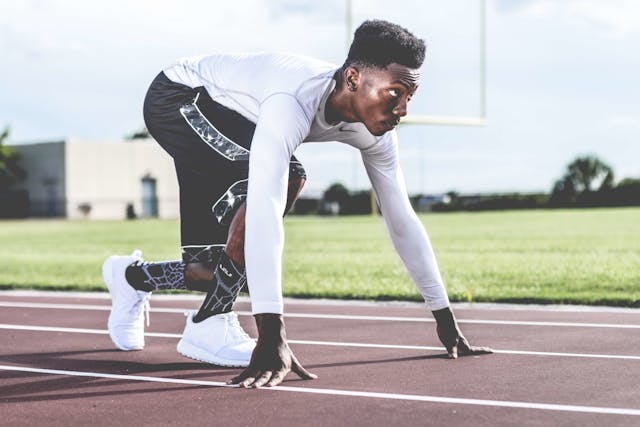How Are New Innovations Making Sports Safer and More Effective for Athletes?
How Are New Innovations Making Sports Safer and More Effective for Athletes?

With rapid advancements in sports technology, athletes today have more tools at their disposal to push their limits safely and perform at their peak.
From blockchain-powered management to cutting-edge materials in football gear, these six innovations are transforming the way athletes train, compete, and stay safe on the field. Here’s a look at some game-changing technologies shaping the future of sports.
How Does Blockchain Help Manage Sports?

As sports teams and organizations grow, so does the complexity of managing them. Blockchain in managing sports offers a modern solution that addresses security, transparency, and data organization. By implementing blockchain technology, sports management systems can ensure that sensitive information—whether related to athlete contracts, ticket sales, or sponsorships—is protected from unauthorized access and tampering. This creates a trustworthy environment where data integrity is maintained, minimizing the risk of fraud and miscommunication.
Blockchain also streamlines player transfers and contract negotiations by enabling secure, tamper-resistant digital records. Teams and agents can benefit from automated, clear, and secure data transactions, which reduce paperwork and eliminate the need for third-party verification.
New Football Equipment Materials Are Making a Difference
When it comes to player safety and helping them perform at higher levels, the materials used in football equipment plays an essential role. High-quality materials have become a crucial focus for manufacturers, who are innovating to produce lighter yet more protective gear.
Today’s football helmets, pads, and gloves are designed with advanced shock-absorbing materials that reduce the risk of concussions and injuries during tackles or falls. Unlike older, bulkier models, these new materials are lightweight, giving players freedom of movement while still offering top-notch protection.
Improving helmet design, for example, has been a priority, with manufacturers now incorporating materials that can absorb impact more effectively, reducing the force on a player’s head. The flexibility and durability of the equipment allow players to perform at their best without compromising safety, especially in a sport as physically intense as football.
Biomechanics to Improve Athletic Performance
Understanding the science of human movement has become integral to enhancing athletic performance. Biomechanics uses video analysis, sensors, and motion capture to examine how athletes move and identify areas for improvement. By analyzing data on muscle activation, joint movement, and body alignment, coaches can tailor training programs that correct inefficiencies, improve technique, and reduce injury risks. For instance, runners can use biomechanics to optimize their stride or body posture, leading to faster speeds and reduced fatigue.
In addition to helping athletes achieve personal bests, biomechanics also helps prevent overuse injuries by monitoring athletes’ movements. When coaches and trainers observe imbalances or repetitive stress in specific body parts, they can adjust training regimens to relieve strain and reduce the likelihood of injury. Whether in gymnastics, soccer, or track and field, biomechanics provides invaluable insights that help athletes maximize their potential.
Wearable Sensors Are Boosting Performance and Safety
Wearable technology has become a vital tool in sports, allowing athletes to gain real-time feedback on their performance. Devices including heart rate monitors, accelerometers, and GPS trackers provide insights on metrics like speed, endurance, and workload. By tracking these stats, athletes and coaches can tailor training sessions to specific needs, monitor fatigue, and prevent overtraining. For example, wearables that measure heart rate variability can signal when an athlete is fatigued, helping them avoid burnout or overexertion.
For injury prevention, wearable sensors can be particularly helpful. Many devices monitor body mechanics, such as posture and joint movement, and alert athletes if they are at risk of injuring themselves. These sensors provide data that athletes can review to make adjustments, strengthening weak areas or altering form to avoid injuries. With wearable technology, athletes can make data-driven decisions that keep them safe and enable consistent, targeted improvement in their performance.
AI and Data Analytics For Personalized Training

Artificial Intelligence (AI) and even data analytics are revolutionizing training programs by offering customized plans based on individual athletes’ needs. Traditional training often follows a one-size-fits-all approach, but AI allows for a highly personalized experience that takes into account an athlete’s strengths, weaknesses, and goals. With AI, trainers can design programs that cater to each athlete’s requirements, monitor progress, and adjust training in real-time to optimize results.
Data analytics also helps in scouting and recruitment by analyzing player performance metrics more efficiently than human scouts can. By examining large volumes of game data, AI identifies patterns and insights that are invaluable for team managers and coaches. The ability to assess data on reaction time, agility, speed, and other key performance indicators helps athletes and teams make informed decisions. This data-driven approach is transforming not only individual training programs but also team strategies, enabling athletes to achieve higher levels of success.
Trending
1 Software Development in Mechanical Engineering: Bridging the Gap Between Design and Reality
Fabrice Beaux2 Cybersecurity Trends 2025
Helen Yu3 adCAPTCHA Partners with Indie Ridge to Protect Global Brands from Bot Attacks
Fabrice Beaux4 How to Build Your Own Software
Daniel Hall5 TSMC Halts AI Chip Production for China
Azamat Abdoullaev

